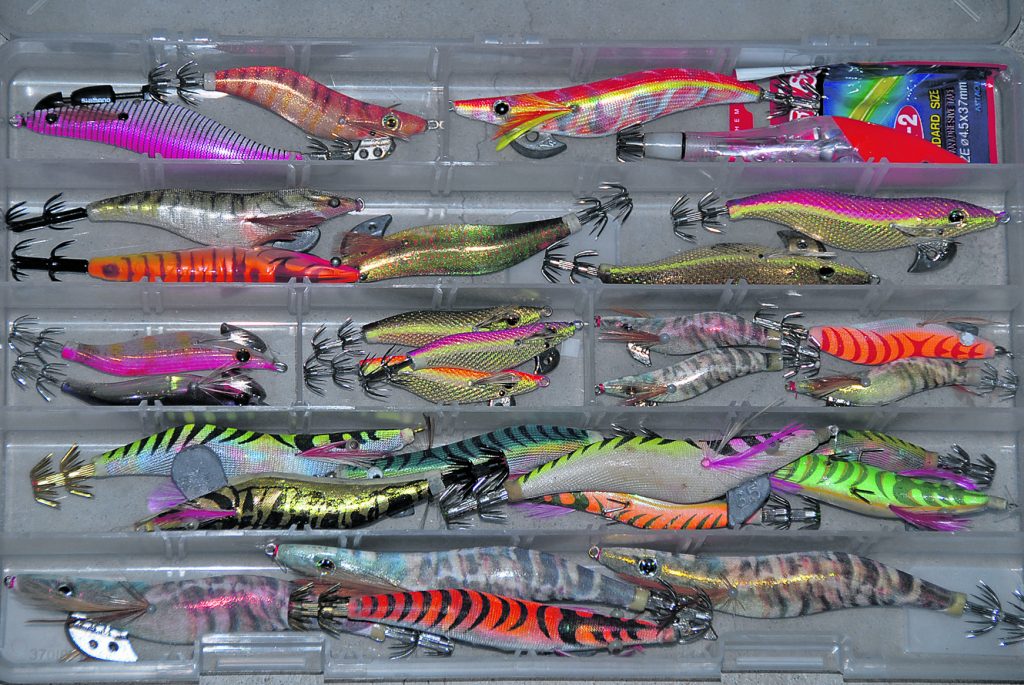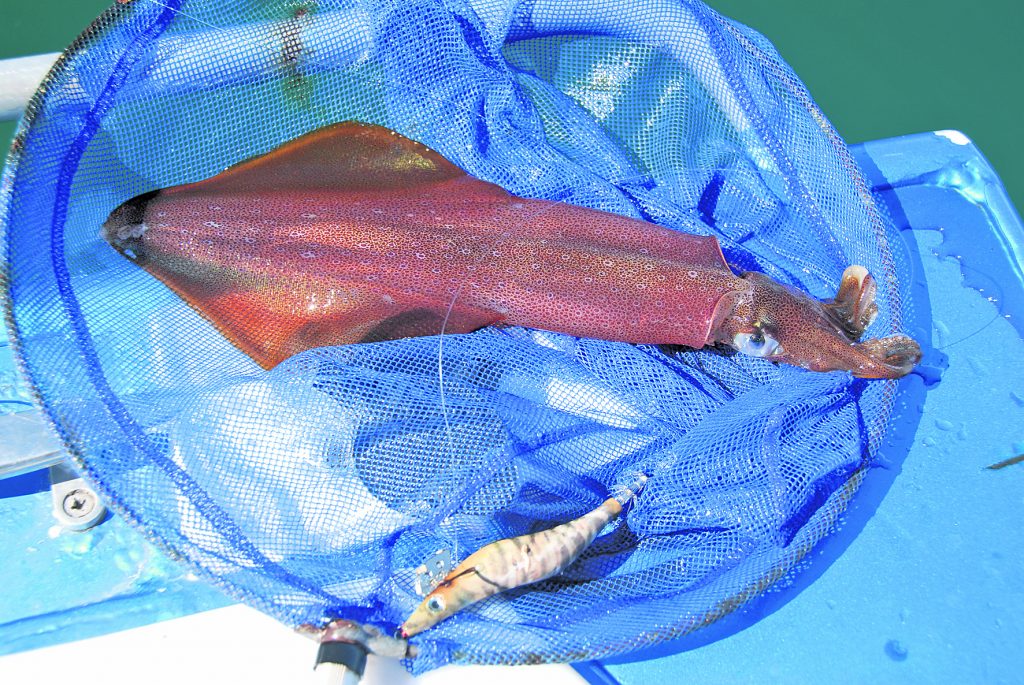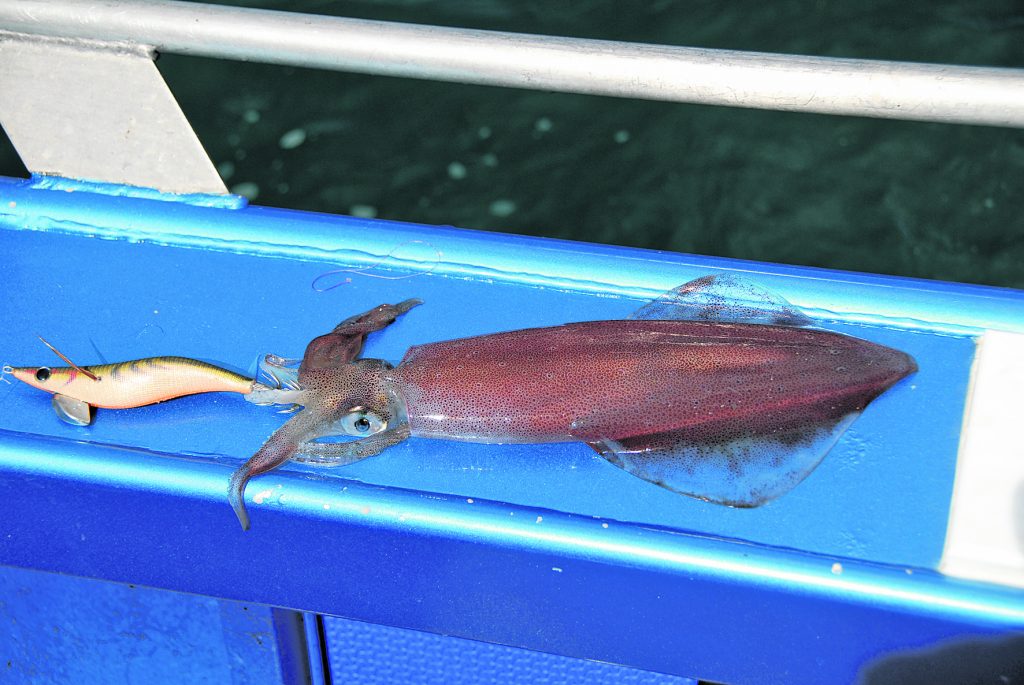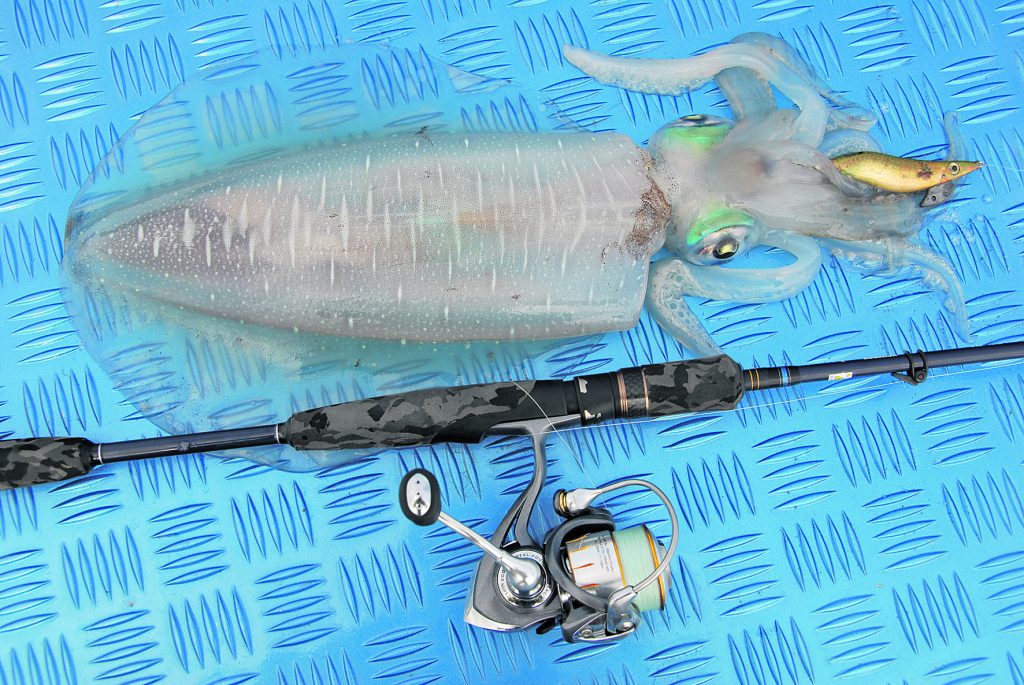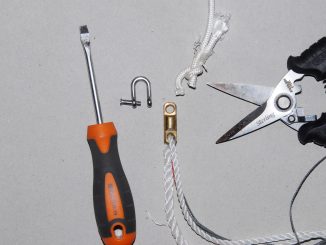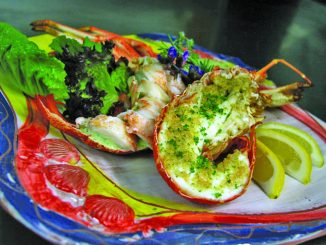
by Gordon MacDonald •
The interest in targeting squid has skyrocketed in recent years, as anglers realise how accessible they are and how much fun they can be to catch. Numerous squid species are prevalent within southern Queensland and you don’t even need a boat to target the succulent cephalopods. They can be caught from most land-based locations along the foreshores of Moreton Bay and waters further afield. Additionally, they can be taken well out into the bay in channels and around the shallows of the bay islands.
At times squid, can be easy to snare, however, in the more heavily probed areas they become rather cagey, offering a real challenge for even the most knowledgeable egi aficionado. Want to have a crack at catching some calamari? This info might whet your appetite…
EXCELLENT EGI
There is not a lot of gear required to go and catch squid, but having the correct type can definitely make the trip a little more successful. The main item you will need is a squid jig or egi (which means wooden lure), as they are now commonly known. It’s somewhat ironic that egi, which are shaped like a prawn with feather wings and rows of barbs at the rear, are now rarely made of wood. Instead, they’re moulded from plastic compounds that are usually coated with various cloths or other finishes. The coatings are designed to make the egi feel like a real prawn or shrimp, which increases the chance of the squid holding onto them longer. This increases the chance of securely hooking them with the rows of razor sharp jags (spikes) at the rear.
Egi are weighted to sink slowly, with different ones sporting regulated sink rates. In faster currents and deeper waters, you will generally use a faster sinking egi, whilst in shallower, slower flowing water a slow sinking version would be best. Additionally, egi come in numerous sizes and a huge array of colours, some with glow-in-the-dark properties. Which colour to choose at what time can be a hard decision at times and often it is a case of trying different ones until you work out what the squid favour.
Usually, however, squid are not that fussy, except in heavily worked zones around the foreshores where they often become wary due to constant pressure. To start out, I would generally advise prospective squidders to get 1 jig with a natural finish and 1 with a bright or glow finish, usually pink, orange or green. If fishing out in the bay, then choose a size 2.5-4.0 egi and for land-based squidding around the foreshores, a 1.2-2.5 sized egi. Obviously, having a wider array at your disposal can increase your chances when the squid are being a little fussy.
It is also possible to catch squid on baits, and we will explore this further in a techniques article, but will only cover targeting squid on egi at present.
SQUID TACKLE
To present your lure you will need an outfit to cast it out. I have seen handlines used, however, a rod and reel will make it a lot easier. Ultimately, a light spin rod is desirable, but many different rods can suffice. A softer tip is a plus, to absorb the lunges of the squid, and a light drag setting will also aid in this regard. Light line (braid or monofilament) to around 6kg is best, and a fluorocarbon leader (which doesn’t attract or reflect light in the water and is low visibility) will allow you to present the jig in a more natural manner.
For the more serious squid-fisher, there are rods designed specifically for the task. These will cast the jig efficiently and increase the chance of hooking and staying connected to the squid. These are usually 2.1-2.7m long and possess slow tapers and actions. This decreases the likelihood of tearing the jig out of the jagged squid when it lunges in an attempt to escape.
To accompany these species-specific rods, there are designated reels possessing light and precise drag setting ability, again to decrease the chance of the squid being able to expel the jig.
I like to attach the egi to my leader with a spiral snap, which aids in quick jig changes when the cephalopods are being difficult. However, you can simply attach the jig with a simple perfection loop or even a blood knot if you wish. While it is nice to have specific tools to use, especially if you decide to get a bit more hard-core in your squidding endeavours, they are not a necessity yet do make squidding easier. To get started though, you only need a couple of egi, some light fluorocarbon leader, and an outfit to cast it with.
RETRIEVE TO DECEIVE
There are many different ways to retrieve your jig to elicit a strike. If you can see the squid then you can often get a good idea as to what retrieve technique it is responding to. Otherwise, try 1 of these techniques. For deeper water, allow the jig to sink right down, almost to the bottom, after casting. Once you think it is in the zone, lift the rod abruptly. Allow the jig to sink before again lifting the rod sharply. This will create an action similar to that of a fleeing prawn, 1 of the squid’s favourite food sources. Strikes will generally come as the jig slowly sinks.
In shallower water, use smaller (less aggressive) hops, or just wind the reel handle slowly with intermittent pauses and the occasional downwards stab of the rod tip. It often pays to mix it up a bit until you can determine what the squid are responding to.
If you feel a little tap (probably only discernible to anglers with graphite rods and braided line), drop the rod tip for a second to allow the squid to pull the jig back to the tentacles with its candles (the 2 long grabbing tentacles) before striking with an upward rod motion. Generally, however, you will only feed a dull weight as the rod tip loads up as the squid retreats with your jig.
Lift the rod firmly to set the barbs and then wind the reel handle with a slow, constant retrieve. Do not pump and wind as you would with a fish, as this will often permit the barbless prongs to be expelled. A light drag setting is desired to minimise the chance of the barbs tearing free as the squid lunges.
Once at close quarters, you can use a fine-meshed landing net or a specific squid gaff (yes, there is such a thing!) to secure your prize. Land-based anglers may just be able to drag the squid ashore. Beware of the black ink expelled (a defence mechanism) and keep the tentacle end facing outwards, away from yourself or the boat (or your mate — or maybe not…). The squid can be dispatched by using a squid spike (like an Iki Jime spike). You will need to stab it twice (on each side, a little behind the eye area) as each side of its body is independent. It will turn instantly white once it is dead. Alternatively, you can just put it on ice.
LOCATING SQUID
We get a few different species of squid in southern Queensland, but the main 2 types encountered will be arrows and tigers. The arrows are long and fairly thin, whilst the tigers are more solid and generally have a strikingly mottled body. One thing that all squid seem to favour is clean, clear water. If this flows over structure such as weed beds, reef, rubble grounds, or even areas with a discoloured bottom that provide squid with the ability to blend in and hide from their prey, then the likelihood of securing a few is heightened.
Good areas to search include the shallows around the bay islands (Peel, Green, Goat, Bird, Mud, King), the weed beds on the western side of Moreton and Stradbroke, areas of discoloured bottom along the edges of the Rous and Rainbow channels, and along any rock walls. Canal developments also provide good habitat for squid, due to the rock walls and the numerous jetties and pontoons affording them suitable ambush and egg laying spots.
Most squid only live for around a year and many can breed 3-5 times in this period. Therefore, it is better to take larger squid, which have already bred several times and are probably close to the end of their life, than the smaller specimens. Interestingly, squid have 4 brains, with 2 controlling each side of the body. I guess you would need more than 1 brain with so many arms and tentacles to operate.
LAND BASED
For land-based squidders, there are a lot of places to try. During the lower stages of the tide, you can walk out to King Island to try your luck in the shallows. However, the higher tidal stages are generally preferred, especially for land-based activity.
The foreshores of Manly, Scarborough, Wellington Point and Victoria Point are good places to begin the search. Many areas of the canal developments can also be explored on Shank’s pony. Anywhere that you can access nice clear water is worth a try, although most squid activity will be concentrated around the reef, rubble, rock or weed bed areas, especially during the day when they are more conspicuous to predators in open water.
During the latter half of winter, westerly winds will increase in prevalence. These offshore breezes create crystal clear conditions close to shore, which is extremely favourable for squid fishing in these zones. Often, the water is so clear that you can spot the squid from an elevated position. Don’t cast directly at it, as you might spook it. Cast ahead or short and then begin retrieving, after allowing the jig to sink a little.
THE DARKENED HOURS
At night, squid can often be found closer to shore, especially around lighted areas that attract baitfish, prawns and other food sources. Due to their over-sized eyes, squid see exceptionally well at night and can be caught in the aforementioned ways. Additionally, however, they can first be spotlighted using a high-powered headlamp such as my 600 lumen Ferei. Even a 220 lumen head lamp will suffice and there are plenty on the market that are good.
Once a squid is spotted, the next step is to cast the jig close to it. I generally switch the headlamp off or to a lower setting to avoid spooking the target. Sometimes a sighted squid may require several egi changes to get it to respond, but on others they will pounce immediately. Squid can often be sighted without the use of a headlamp around illuminated areas or periods close to the full moon during still conditions.
CONCLUSION
I hope I didn’t make squid fishing sound too hard or technical. While there are a lot of intricacies that can be associated with it, squid fishing can is an extremely easy task most of the time. Even a squid jig cast out behind the boat as you slowly drift around the bay islands is likely to get pounced upon. When the tip loads up, it is just a case of slowly winding the squid in.
Casting egi from the bank is extremely easy and can be very productive during the colder months when water clarity is high. Squid fishing can be a trip in itself or a side pursuit during a day’s fishing to secure a tasty entree. It is normally exceptionally easy and is ideal for inexperienced anglers and children, as the squid will generally impale themselves with ease.
Have a go at squidding; it’s an ‘egicellent’ way to secure one of the ocean’s most scrumptious delights!

